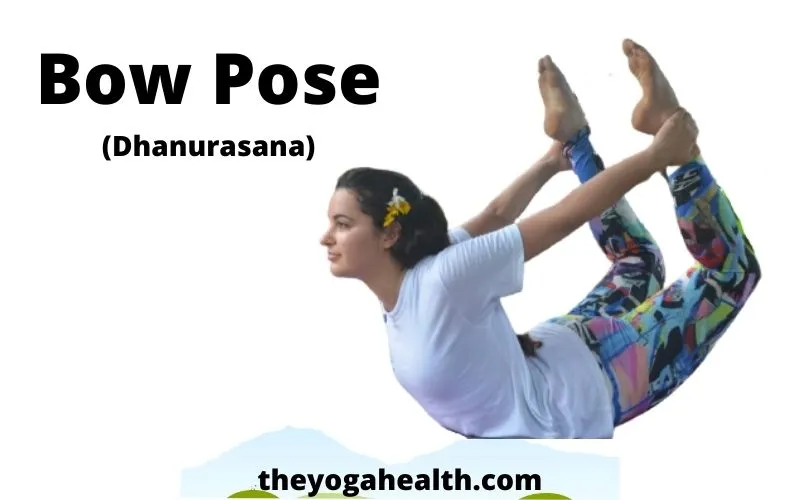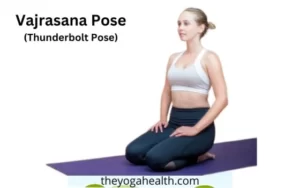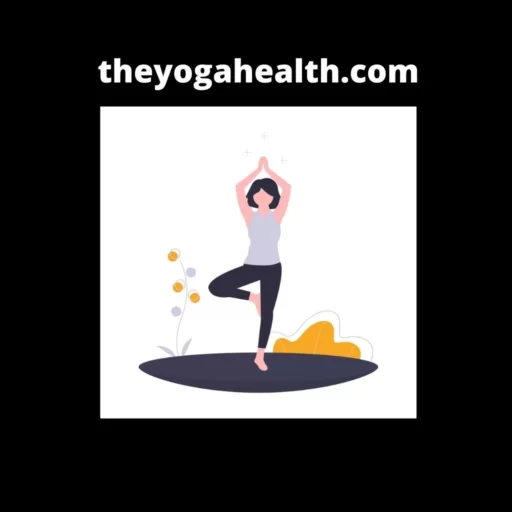Bow pose in yoga or Dhanurasana posture offers a lot of health benefits to the regular practitioner of Yoga. Dhanurasana is a basic pose of Hatha yoga. ‘Dhanur’ in the Sanskrit language means ‘bow’ thus, this asana is also known as a ‘Bow Pose’.
In this pose the hands are used like a bow-string to pull the head, trunk, and legs, thus the asana resembles a bent bow. So this asana is called Dhanurasana in Sanskrit.
Table of Contents
Bow Pose (Dhanurasana)
In this asana, the spine is fully stretched back. Generally, we find elderly people have a rigid spine, it is because they do not do this asana regularly. Dhanurasana brings back elasticity in the spine as it was during childhood.
This asana also tones the abdominal organs. Those persons who have a slip-disc problem, if they regularly practice Dhanurasana and Salabhasna, they obtain relief from back pain without going through surgical treatment.
Dhanurasana meaning
Dhanurasana is comprised of two words, ‘Dhanur’ and ‘asana’. In the Sanskrit language ‘Dhanur’ means ‘bow’ and asana means ‘posture’ or ‘pose’. In English, this asana is known as ‘bow pose’
Basic Details
| Sanskrit Name: | Dhanurasana |
| English name: | Bow Pose |
| Meaning: | Dhanur means ‘Bow’ and Asana means ‘Pose’ or ‘Posture’ |
| Difficulty Level: | Beginner |
| Position: | lying on the floor, belly down |
Bow Pose Steps
1. Lie down on a floor on the stomach, face down.
2. Now breathe out and bend your knees. Now Stretch your arms back and catch your left ankle with your left hand and right ankle with your right hand. Now take two-three, breaths.
3. Now fully breathe out and pull your legs up by raising the knees above the floor and simultaneously also lift the chest from the floor. The arms and the hands now act as a bowstring and the body is stretched like a bent bow.
4. Lift your head and pull it back as far as possible for you. Ribs and pelvic bones should also be lifted off the floor. Your abdomen should bear the entire weight of the body on the floor.
5. When you are raising the legs from the floor do not join them at the knees because then you will not be able to lift them high from the floor. After the full stretch upwards has been achieved now you can join the thighs, knees, and ankles.
6. As the stomach bears the entire weight of the body and is fully stretched, breathing will be difficult and fast. Do not worry about the fast breathing. You can stay in this asana as per your capacity from a few seconds to 1 minute.
7. After that breathe out and release your ankles and slowly bring down your legs and head back to the floor.
For the beginners when they start doing this pose they will find it difficult to raise their legs upwards but as they grow in practice it will become easier day by day.
There are tremendous health benefits to the person who regularly practice Dhanurasana, particularly for obese persons who want to reduce their body weight.
Bow Pose Benefits:
This yoga pose has variety of benefits that can improve your health in many different ways.
- Improves Body Posture: This is a fantastic yoga posture that works wonders for your body alignment. Regular practice of this pose helps in correcting posture issues and ensures you stand tall and confident.
- Enhances Digestion and Appetite: By engaging your abdominal muscles, this Pose aids in improving digestion and stimulating your appetite. Say goodbye to digestive woes with this effective yoga pose.
- Alleviates Respiratory Disorders: For those suffering from respiratory issues like asthma, this Pose can be a game-changer. The chest expansion in this pose opens up the lungs, promoting better respiratory function.
- Combats Obesity and Rheumatism: This is a dynamic asana that helps in shedding excess body weight and reduces the symptoms of rheumatism. It stimulates the metabolism, supporting your weight loss journey.
- Relieves Constipation: Bid farewell to the discomfort of constipation by incorporating this Pose into your daily routine. The gentle pressure on your abdomen aids in regulating bowel movements.
- Effective Weight Loss Tool: For individuals striving to lose weight, this Pose can be an excellent addition to your fitness regimen. Its challenging nature burns calories and accelerates fat loss.
- Restores Spinal Flexibility: If you spend long hours sitting or have a sedentary lifestyle, this Pose can be a savior. It stretches and strengthens the spine, enhancing its flexibility and reducing stiffness.
- Tones Back Muscles: Say hello to a strong and toned back! this Pose targets the back muscles, making them more resilient and supporting your spine’s health.
- Stimulates Reproductive Organs: This Pose is particularly beneficial for women as it helps in stimulating the reproductive organs, promoting better reproductive health.
- Stress Reliever: Life can get stressful, but this Pose has your back! This asana helps in releasing tension and stress, leaving you feeling relaxed and rejuvenated.
- Soothes Back Pain: If you suffer from back pain, this Pose can offer relief. Its stretching action alleviates backache and discomfort.
- Aids in Menstruation Disorders: For women experiencing menstrual issues, this Pose can be a natural remedy to find relief and ease menstrual discomfort.
- Boosts Kidney and Liver Function: This Pose stimulates the kidneys and liver, enhancing their functions and promoting detoxification.
- Improves Blood Circulation: The stretching and compressing actions involved in this Pose enhance blood circulation throughout the body, ensuring a healthier cardiovascular system.
- Assists Diabetes Management: For individuals managing diabetes, this Pose can be a supportive practice. The pancreas is stimulated by this pose, which aids in better insulin output and blood sugar regulation.
- Strengthens Ankles, Thighs, Groins, Chest, and Abdomen: This Pose addresses a variety of muscle groups as a thorough fully body workout, providing you strength and stability.
Precautions And Contraindications:
People having the following conditions should not practice this Pose:
1. If they are suffering from high or low blood pressure.
2. If they are having a hernia.
3. Pregnant women.
4. If the person has undergone any recent abdominal operation or surgery.
5. If a person is suffering from any injury in the lower back, thighs, wrists, shoulders, or neck.
Always start doing yoga asana under the expert guidance of well trained and experienced yoga teacher.
If you are suffering from any health issues then always consult your regular physician before you start doing this asana.
Try to practice this asana in the morning time after you have cleared your bowels. Morning time is the preferred time but if you have to do this asana at any other time then make sure that you have had your meals at least 4 hours before you perform this asana.
Do not do this asana immediately after eating or drinking anything.
Conclusion: For Bow Pose
Including Bow Pose (Dhanurasana) in your daily routine will help you reap a variety of health advantages, including better digestion and posture as well as less stress and strengthened muscles. Keep doing it and take pleasure in the good changes it makes to your body and mind.
It is a very beneficial asana, and can help in curing many diseases of the body, particularly related to the abdominal area.
It tones up and strengthens all abdominal organs and it is very helpful in reducing excess body fat from the body. This asana is also very helpful in improving digestion and flexibility in the body.
FAQ: Bow Pose (Dhanurasana)
Q1. How to do BowPose?
Ans: The step by step procedure to do this Pose is described above in the article.
Q1. What is BowPose (Dhanurasana)?
It is a yoga posture that resembles an archer’s bow. In this pose, the practitioner lies on their stomach and grasps the ankles, lifting the chest and legs off the ground to create a bow-like shape with the body.
Q2. How does BowPose benefit the body?
This Pose offers numerous benefits to the body, such as improving body posture, enhancing digestion and appetite, relieving respiratory disorders like asthma, aiding in weight loss, and strengthening back muscles, among others.
Q3. Is BowPose suitable for beginners?
This Pose can be challenging for beginners, but with regular practice and proper guidance from a qualified yoga instructor, beginners can gradually work towards mastering the pose.
Q4. Can BowPose help with back pain?
Yes! this Pose is recommended for people who suffer from back pain, regular practice of this pose will definitely give relief from the back pain. The stretching and strengthening of the back muscles in this pose can alleviate discomfort and improve spine flexibility.
Q5. Is BowPose beneficial for weight loss?
Yes, this Pose is beneficial for weight loss as it engages various muscle groups and increases metabolism, which can support fat burning and weight management efforts.
Q6. Can BowPose cure respiratory disorders like asthma?
While this Pose can be beneficial for improving respiratory function, it is essential to understand that it may not cure asthma or any other respiratory disorder entirely. It can, however, be a supportive practice for individuals with such conditions.
Q7. How often should I practice BowPose?
The frequency of this Pose practice can vary depending on your fitness level and flexibility. It is generally recommended to practice it 3-5 times a week to experience its benefits.
Q8. Can pregnant women practice BowPose?
Pregnant women are advised to avoid this Pose, especially during the later stages of pregnancy, as it involves intense stretching and pressure on the abdomen.
Q9. Does BowPose help with menstrual disorders?
Yes, this Pose is certainly good for menstrual cramps, make sure to practice this pose regularly if you suffer from menstrual disorders, this Pose helps with menstrual disorders by promoting better reproductive health and relieving menstrual discomfort. But avoid doing this pose during the menstrual periods.
Q10. How long should I hold BowPose during a practice session?
The duration of holding this Pose can vary depending on your comfort level. Beginners can start by holding the pose for 15-30 seconds and gradually increase the duration as they become more comfortable and flexible.
Q11. Can BowPose be done on an empty stomach?
It is generally recommended to practice this Pose on an empty stomach or at least 4-6 hours after a heavy meal. Practicing on an empty stomach allows for better ease of movement and reduces the risk of discomfort.
Q12. Can BowPose be practiced by people with back injuries?
People with back injuries should approach this Pose with caution. Better to seek guidance from a qualified yoga instructor or healthcare professional to see if the pose is suitable for their specific condition or not.
You may also like:
- Headstand (Sirsasana)
- Butterfly yoga pose (Baddha Konasana)
- Cobra Pose ( Bhujangasana)
- Urdhva Prasarita Padasana
Share your experience of doing this pose and let us know if you have any questions or comments regarding this Pose in the comments section below.





